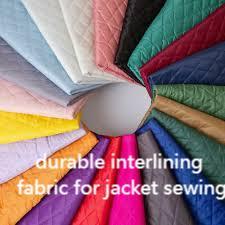In modern fashion design, understanding the role of Interlining is essential. Properly selected Interlining improves garment structure, durability, and overall comfort. It provides stability to fabrics while maintaining flexibility, allowing designers to craft clothing that looks refined and feels comfortable. From professional attire to casual wear, incorporating the right materials ensures longevity and enhances the visual appeal of finished products. Recognizing the advantages of quality support layers can significantly elevate the standard of apparel in competitive markets, combining both functional and aesthetic benefits.
1. Material Varieties for Optimal Results
Different materials offer unique benefits. Woven fabrics provide robust structure, ideal for collars and cuffs. Non-woven options are lightweight and versatile, suited for shirts, blouses, and light jackets. Knitted variations give elasticity, perfect for garments that demand stretch and comfort. Understanding these differences allows manufacturers to match each fabric type with the most suitable supporting material.
2. Key Applications in Garment Construction
Support layers enhance garment quality in multiple ways. They maintain the shape of collars, cuffs, plackets, and waistbands. For outerwear like coats and jackets, these layers add body without excessive bulk. By integrating them properly, designers can ensure clothing retains its form even after repeated wear. Additionally, careful placement enhances both comfort and the wearer’s appearance.
3. Techniques for Attaching Support Layers
Attachment methods influence garment functionality. Fusing uses heat-activated adhesives to bond layers to fabrics, creating a smooth finish without stitching. Sew-in techniques provide more control over drape and flexibility but require meticulous craftsmanship. Selecting the right method depends on garment design, intended use, and performance expectations, balancing aesthetics with practical durability.
4. Innovations in Material Technology
Advancements in material science have introduced eco-friendly, high-performance options for support layers. These innovations allow garments to achieve durability while being lightweight and environmentally conscious. Designers increasingly rely on these modern materials to meet sustainability goals and produce garments that are both stylish and responsible. Quality and innovation combine to deliver superior results.
5. Tips for Designers and Manufacturers
To maximize garment performance, designers should consider fabric type, structure, and use-case scenarios. Weight, stiffness, and flexibility must be balanced to ensure comfort without compromising support. Testing small samples before full production helps guarantee consistent quality. Strategic integration of support layers enhances the overall appeal, durability, and wearer satisfaction. For further information and product insights, visithttps://www.interlining-factory.com/news/what-is-interlining-types-applications-and-more.html .

